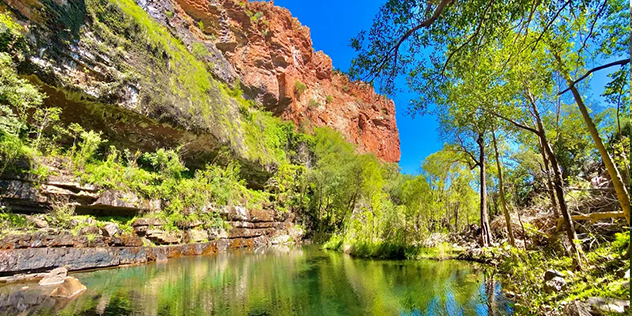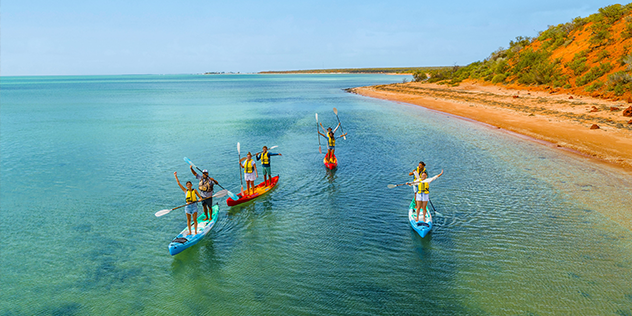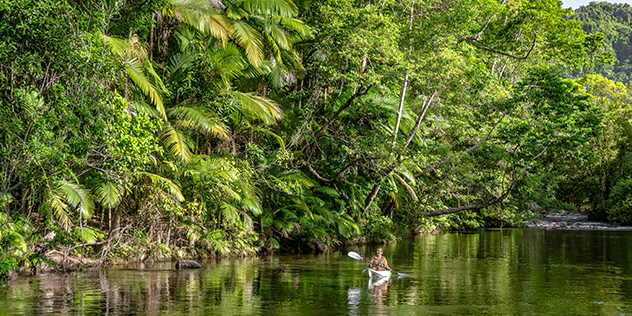Take the plunge: Australia’s special swim spots

Experience more than a refreshing dip at these special swimming spots. A secret waterhole, a crystal-clear lagoon, and a surprisingly chilly rainforest river—on the surface these diverse swimming spots appear to have little in common, but when you explore them in the company of an Aboriginal guide, you’ll discover why they are so special.
Secret Springs
With so many incredible swimming holes and waterfalls in East Kimberley, it’s hard for Bec Sampi, head guide for Kingfisher Tours, to choose a favourite swimming spot. But, when pushed, nominates a waterfall known as ‘Secret Springs’ by the locals.
‘It’s a beautiful little oasis about 20 kilometres out of Kununurra on a bush track,’ Bec says.
‘The road in has beautiful scenery. You've got the ranges, the hills, the greenery. It's just stunning. The creek bed crossing is filled with water, beautiful clean water, and when you get to the Secret Springs area, we have a picnic lunch, then take them up for a swim. There’s a little pool at the bottom or, if they want to climb up to the top, there is a beach pool up there.
'And it's beautiful. There’s lot of fishes in there. No crocodiles anywhere.'
The area around the Secret Springs was once a stopover place for Aboriginal people travelling between Wyndham and Kununurra.
‘Aboriginal people were very nomadic back in the day, and they’d camp along there where the food was plentiful,’ Bec says.
Secret Springs is just one of a number of little-known swimming spots that Bec takes people to during her tours.
‘Depending how the falls are, we take them to Middle Spring. You can go right up to the top of that waterfall as well, and you can swim in your own little pool up there, overlooking the town (Kununurra). We take them to Molly Spring, another little beautiful oasis, as well.’

Secret Springs. Credit: Tourism Australia.
Big Lagoon
Part of the Shark Bay World Heritage Area, Big Lagoon is not just an incredibly scenic place to swim, kayak and snorkel, it’s a place to connect to Country, says Darren ‘Capes’ Capewell.
Capes is a Nhanda man from Gutharraguda, the place of Two Waters, which is also known as Shark Bay World Heritage Area. He leads Wula Gura Nyinda Eco Cultural Adventures' kayaking and wildlife tours to Big Lagoon within Francois Peron National Park/Wulyibidi.
It’s an area known for its majestic blood-red cliffs and crystal-clear turquoise waters that teem with birds, small school sharks, rays, dolphins, and dugongs.
But with his tour numbers capped at a maximum of 12, a day at Big Lagoon offers people more than a rare opportunity to swim and kayak on a deserted beach. With Capes as their guide, guests are able to literally immerse themselves in the spirit of Sea Country.
‘It's just a wonderful opportunity for people to reconnect to our natural environment. That's what our take home message is—we want people to be open and to be able to receive the spirit of Country. It's part of a reawakening or awakening if you like—for people to understand what our connection is to the planet or to the environment that sustains us.’
And Big Lagoon, the place where the desert meets the sea, is the perfect place for guests to have that experience, he says.
‘It has the energy of the ocean as well as the energy of the desert because of the red sand.’

Shark Bay World Heritage Area. Credit: Tourism Australia.
Mossman River
Juan Walker loves concluding his Walkabout Cultural Adventures tours of the Daintree and Mossman Region with a walk through the rainforest and a swim in the Mossman River to unwind and reconnect.
The spot he has selected is ideal for a dip, with small rapids and big and beautiful crystal-clear pools. The sand and algae on the rocks turn the water a hypnotic kaleidoscope of greens and yellows. They are edged with a mix of large, rounded boulders, and rocks with flat tops that seem to have been custom made for swimmers to lie on, and dry after a dip. The water isn’t that cold, yet people often get a surprise when they jump in.
‘It's not really freezing, it's just the difference from air temperature to water temperature. So, it's a bit of a shock to the system and they think it's a lot colder than what it actually is,’ Juan says. ‘Because it's so cool and high in nitrogen, it feels amazing. You feel very cleansed and have very soft hair and skin all over.’
‘It’s one of my favourite places to go because it has fresh water, great swimming holes, and it’s just beautiful. It’s very peaceful and has a great energy from the rainforest around it.’
The magic of the spot is even more potent for Juan. This is his grandmother’s Country—and she was born along this very river.

Mossman River in the Daintree. Credit: Tourism Australia.
Note: The NRMA is in partnership with Tourism Australia’s Discover Aboriginal Experiences. We are committed to promoting First Nations culture and experiences. Note: The original text has been modified for clarity and style.






